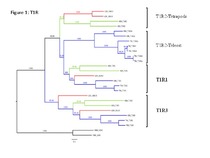| dc.contributor.author | Picone, Barbara | |
| dc.contributor.author | Hesse, Uljana | |
| dc.contributor.author | Panji, Sumir | |
| dc.contributor.author | Van Heusden, Peter | |
| dc.contributor.author | Jonas, Mario | |
| dc.contributor.author | Christoffels, Alan | |
| dc.date.accessioned | 2015-09-15T19:28:33Z | |
| dc.date.available | 2015-09-15T19:28:33Z | |
| dc.date.issued | 2014 | |
| dc.identifier.citation | Picone, B., et al. (2014). Taste and odorant receptors of the coelecanth- a gene repertoire in transition. Journal of Experimental Zoology Part B: Molecular and Developmental Evolution. 322(6): 403-414 | en_US |
| dc.identifier.issn | 0022-104X | |
| dc.identifier.uri | http://hdl.handle.net/10566/1608 | |
| dc.description.abstract | G-protein coupled chemosensory receptors (GPCR-CRs) aid in the perception of odors and tastes in vertebrates. So far, six GPCR-CR families have been identified that are conserved in most vertebrate species. Phylogenetic analyses indicate differing evolutionary dynamics between teleost fish and tetrapods. The coelacanth Latimeria chalumnae belongs to the lobe-finned fishes, which represent a phylogenetic link between these two groups. We searched the genome of L. chalumnae for GPCR-CRs and found that coelacanth taste receptors are more similar to those in tetrapods than in teleost fish: two coelacanth T1R2s co-segregate with the tetrapod T1R2s that recognize sweet substances, and our phylogenetic analyses indicate that the teleost T1R2s are closer related to T1R1s (umami taste receptors) than to tetrapod T1R2s. Furthermore, coelacanths are the first fish with a large repertoire of bitter taste receptors (58 T2Rs). Considering current knowledge on feeding habits of coelacanths the question arises if perception of bitter taste is the only function of these receptors. Similar to teleost fish, coelacanths have a variety of olfactory receptors (ORs) necessary for perception of water-soluble substances. However, they also have seven genes in the two tetrapod OR subfamilies predicted to recognize airborne molecules. The two coelacanth vomeronasal receptor families are larger than those in teleost fish, and similar to tetrapods, form V1R and V2R monophyletic clades. This may point to an advanced development of the vomeronasal organ as reported for lungfish. Our results show that the intermediate position of Latimeria in the phylogeny is reflected in its GPCR-CR repertoire. | en_US |
| dc.description.sponsorship | The South African Research Chairs Initiative of the Department of Science and Technology and the National Research Foundation: Grant 64751. | en_US |
| dc.language.iso | en | en_US |
| dc.publisher | Wiley | en_US |
| dc.rights | © 2013 Wiley Periodicals, Inc. "This is the pre-peer reviewed version of the following article: [Picone, B., et al. (2014). Taste and odorant receptors of the coelecanth- a gene repertoire in transition. Journal of Experimental Zoology Part B: Molecular and Developmental Evolution. 322(6): 403-414], which has been published in final form at [http://dx.doi.org/10.1002/jez.b.22531]. This article may be used for non-commercial purposes in accordance with Wiley Terms and Conditions for Self-Archiving." | |
| dc.source.uri | http://dx.doi.org/10.1002/jez.b.22531 | |
| dc.subject | Chemosensory receptors | en_US |
| dc.subject | Coelecanth | en_US |
| dc.subject | Phylogenetic analysis | en_US |
| dc.subject | Olfactory receptors | |
| dc.title | Taste and odorant receptors of the coelecanth- a gene repertoire in transition | en_US |
| dc.type | Article | en_US |
| dc.privacy.showsubmitter | false | |
| dc.status.ispeerreviewed | true | |
| dc.description.accreditation | Web of Science | en_US |

